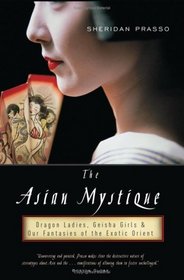Helpful Score: 1
This book lets you realise that the stereotype we generally have about Asians and their culture have been askewed by the writings of individuals who only sawm or want to see to see, one side of an entire culture.
Sophia C. reviewed The Asian Mystique: Dragon Ladies, Geisha Girls, Our Fantasies of the Exotic Orient on + 289 more book reviews
The Asian Mystique: Dragon Ladies, Geisha Girls, and Our Fantasies of the Exotic Orient is a nuanced but somewhat jumbled work examining how Westerners view Asia. Sheridan Prasso, a journalist once based in Asia, contends that the West, through a distorted lens, sees the Orient as a weaker but exotic, sensual and decadent place. The first part of the book is a heavily researched investigation into how that lens was constructed. She documents the first East-West interactions and how they became the basis of continually reinforced prejudices. She also devotes separate chapters to how Hollywood portrays Asian women and men from early 20th century until today.
The second part of the book, "Ten People, Ten Colors," consists of first-hand research involving talking to and following around Asian women. Prasso visits a geisha--the one who inspired Arthur Golden's Memoirs of a Geisha but ultimately suing him for misrepresentation--as well as prostitutes, female politicians, Cathay stewardesses, among others in Southeast and East Asia. Here the text is more about the condition of women in Asia, and not the stereotypes thereof. The Indian subcontinent is not a focus of this work.
Ultimately, I think the author's message is that being consumers of an Asian Mystique is ultimately deleterious to Westerners, as well as Asians. However, some of this message is diluted since most of the book concerns itself with documenting its existence. The Asian Mystique does an admirable job of not showing this as an unidirectional imposition of stereotypes; Asians sometimes play into and perpetuate this facade too.
The second part of the book, "Ten People, Ten Colors," consists of first-hand research involving talking to and following around Asian women. Prasso visits a geisha--the one who inspired Arthur Golden's Memoirs of a Geisha but ultimately suing him for misrepresentation--as well as prostitutes, female politicians, Cathay stewardesses, among others in Southeast and East Asia. Here the text is more about the condition of women in Asia, and not the stereotypes thereof. The Indian subcontinent is not a focus of this work.
Ultimately, I think the author's message is that being consumers of an Asian Mystique is ultimately deleterious to Westerners, as well as Asians. However, some of this message is diluted since most of the book concerns itself with documenting its existence. The Asian Mystique does an admirable job of not showing this as an unidirectional imposition of stereotypes; Asians sometimes play into and perpetuate this facade too.




